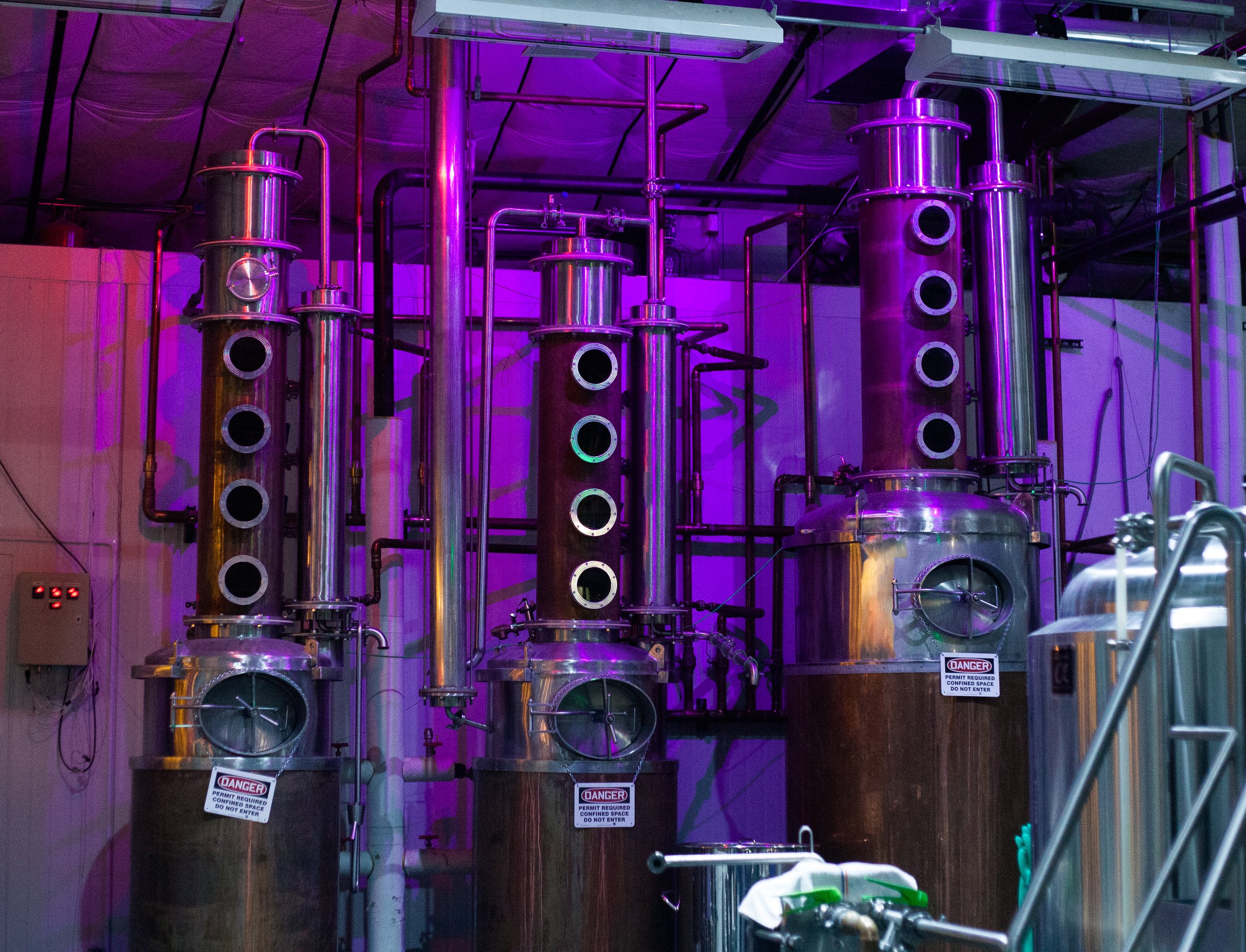Meet Our Three Stills!
Distillation, in a nutshell, is the separation of molecules based on boiling point. Ethanol has a lower boiling point than water (about 176 degrees Fahrenheit in Colorado) and by holding product at a temperature below the boiling point of water you are able to collect the vapor being produced by condensing it back into a liquid, and the lighter that compound, the lower the boiling point will be.
In distillation there are what are called your heads, hearts and tails cuts. The heads are going to be the lightest, most volatile compounds such as acetone and methanol. These two substances can cause you to get sick and possibly go blind, so those are collected first and tossed or redistilled. The second cut is going to be your hearts. This is all the ethanol, or the good stuff we drink. The last thing to leave the still is going to be your tails. These are fusel oils left over from the grain and then eventually water will be the only thing remaining. Tails can be cut into when producing more flavorful spirits to add some of the grain character back to the spirit. The amount collected is up to the distiller.
In every distillery the stills are the most important and, oftentimes, the most unique aspect of the production floor. There are several different types of still design; pot, column, hybrid, vacuum ect. Ironton Distillery has three pot/column hybrid stills, each serving a different purpose. Most spirits will be distilled a handful of times before they are bottled as a finished product.
The more times you distill something the less flavor will be kept from the starting wash. This is why most vodkas are distilled between three and six times. Depending on the product we are making at Ironton, it could be passed through the still anywhere from one to four times.
In order from left to right: Tamila, Margot and Karl.
Big Daddy Karl
All of the products will start the distillation process in the same way. This is where the large still gets utilized. Our stripping still, or Karl as we call him, is unique in the fact that it is three times the size of the other two. All of the distillers wash will be transferred into our stripping still for its first distillation.
Distillers wash is anywhere from 7-10% ABV depending on the product we are making. Think of it as an unhopped, uncarbonated beer. The purpose of the stripping still is to strip the wash of everything that resembles that beer like product and transform it into a clear distilled spirit.
At this stage in the process we do not take any cuts, we keep all the product we can so we can get more accurate cuts on the second distillation. The stripping still will take that 350 gallons of wash and replace it with 50 gallons of 90 proof or 45% ABV spirit. At this point the product is called low wines because it is lower in proof.
Margot The Processor
From Karl, the low wines are transferred into the spirit still named Margot! The spirit still is also a hybrid still, and it is where that column becomes very important.
It works by taking the alcohol in the pot and bringing it up to the heat of vaporization, different compounds are boiled off at different temperatures hence the heads, hearts and tails cuts. As the vapor rises through the column it will hit the bubble cap (basically a copper cap over an open tube) as the vapor hits the copper it is recondensed back to its liquid form and drop back into the pot where it will be heated again and sent through the same process.
Once the product is pure enough, it will find its way through the column and down through the condenser (a tube in tube heat exchanger passing cold liquid through the lines to condense alcohol vapor into its liquid final state).
The product coming off here is about 160 proof and is now called “high wines”. This is where we are going to make those cuts mentioned above. The heads cuts are done by taste by the distiller and the tails cuts are made by recipe.
Whiskeys and rums will only be passed through the spirit still once (two distillations). Vodka will get passed through 2 times (three total). Gin will get passed through 2 times and then once through the botanical still (four total).
The Botanical Lady Tamila
Last but certainly not least is the botanical still. We call her Tamila.
The botanical still looks and operates the same as the spirit still with one exception. On the top of the copper column there is a basket that holds botanicals for the gin. Botanicals can be incorporated into gin two ways, through maceration (basically steeping) and boiling or vapor infusion. Ironton uses both methods.
As the vapor passes through the column and basket on the botanical still it picks up the oils from the botanicals inside.
As to the names of the stills, they all are unique in their own way and have different personalities. Karl is the rock solid big daddy still, Margot is beautiful, somber but can have a bit of a temper and Tamila is a free spirit rolling around in the botanicals! Hope this was fun and informative!!


